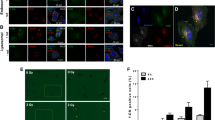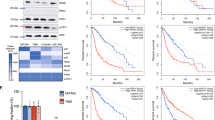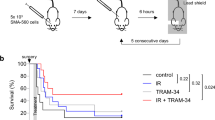Abstract
More than half of malignant gliomas reportedly have alterations in the p53 tumor suppressor gene. Because p53 plays a key role in the cellular response to DNA-damaging agents, we investigated the role of p53 gene therapy before ionizing radiation in cultured human glioma cells containing normal or mutated p53. Three established human glioma cell lines expressing the wild-type (U87 MG, p53wt) or mutant (A172 and U373 MG, p53mut) p53 gene were transduced by recombinant adenoviral vectors bearing human p53 (Adp53) and Escherichia coli β-galactosidase genes (AdLacZ, control virus) before radiation (0–20 Gy). Changes in p53, p21, and Bax expression were studied by Western immunoblotting, whereas cell cycle alterations and apoptosis were investigated by flow cytometry and nuclear staining. Survival was assessed by clonogenic assays. Within 48 hours of Adp53 exposure, all three cell lines demonstrated p53 expression at a viral multiplicity of infection of 100. p21, which is a p53-inducible downstream effector gene, was overexpressed, and cells were arrested in the G1 phase. Bax expression, which is thought to play a role in p53-induced apoptosis, did not change with either radiation or Adp53. Apoptosis and survival after p53 gene therapy varied. U87 MG (p53wt) cells showed minimal apoptosis after Adp53, irradiation, or combined treatments. U373 MG (p53mut) cells underwent massive apoptosis and died within 48 hours of Adp53 treatment, independent of irradiation. Surprisingly, A172 (p53mut) cells demonstrated minimal apoptosis after Adp53 exposure; however, unlike U373 MG cells, apoptosis increased with radiation dose. Survival of all three cell lines was reduced dramatically after >10 Gy. Although Adp53 transduction significantly reduced the survival of U373 MG cells and inhibited A172 growth, it had no effect on the U87 MG cell line. Transduction with AdLacZ did not affect apoptosis or cell cycle progression and only minimally affected survival in all cell lines. We conclude that responses to p53 gene therapy are variable among gliomas and most likely depend upon both cellular p53 status and as yet ill-defined downstream pathways involving activation of cell cycle regulatory and apoptotic genes.
This is a preview of subscription content, access via your institution
Access options
Subscribe to this journal
Receive 12 print issues and online access
$259.00 per year
only $21.58 per issue
Buy this article
- Purchase on Springer Link
- Instant access to full article PDF
Prices may be subject to local taxes which are calculated during checkout
Similar content being viewed by others
Author information
Authors and Affiliations
Corresponding author
Rights and permissions
About this article
Cite this article
Badie, B., Goh, C., Klaver, J. et al. Combined radiation and p53 gene therapy of malignant glioma cells. Cancer Gene Ther 6, 155–162 (1999). https://doi.org/10.1038/sj.cgt.7700009
Received:
Accepted:
Published:
Issue Date:
DOI: https://doi.org/10.1038/sj.cgt.7700009
Keywords
This article is cited by
-
TRIM22 promotes the proliferation of glioblastoma cells by activating MAPK signaling and accelerating the degradation of Raf-1
Experimental & Molecular Medicine (2023)
-
Immune microenvironment of gliomas
Laboratory Investigation (2017)
-
Malignancy-associated metabolic profiling of human glioma cell lines using 1H NMR spectroscopy
Molecular Cancer (2014)
-
Inhibition of Casein kinase-2 induces p53-dependent cell cycle arrest and sensitizes glioblastoma cells to tumor necrosis factor (TNFα)-induced apoptosis through SIRT1 inhibition
Cell Death & Disease (2012)
-
Molecular fingerprinting of radiation resistant tumors: Can we apprehend and rehabilitate the suspects?
BMC Cancer (2009)



